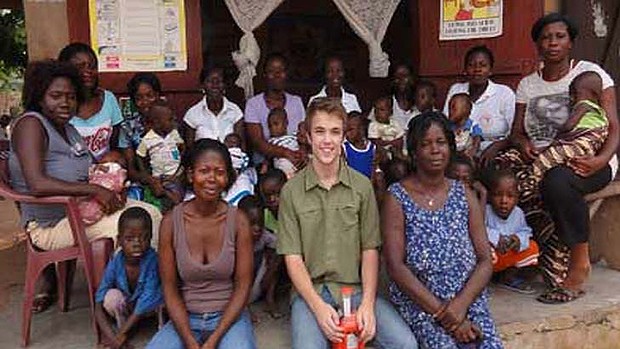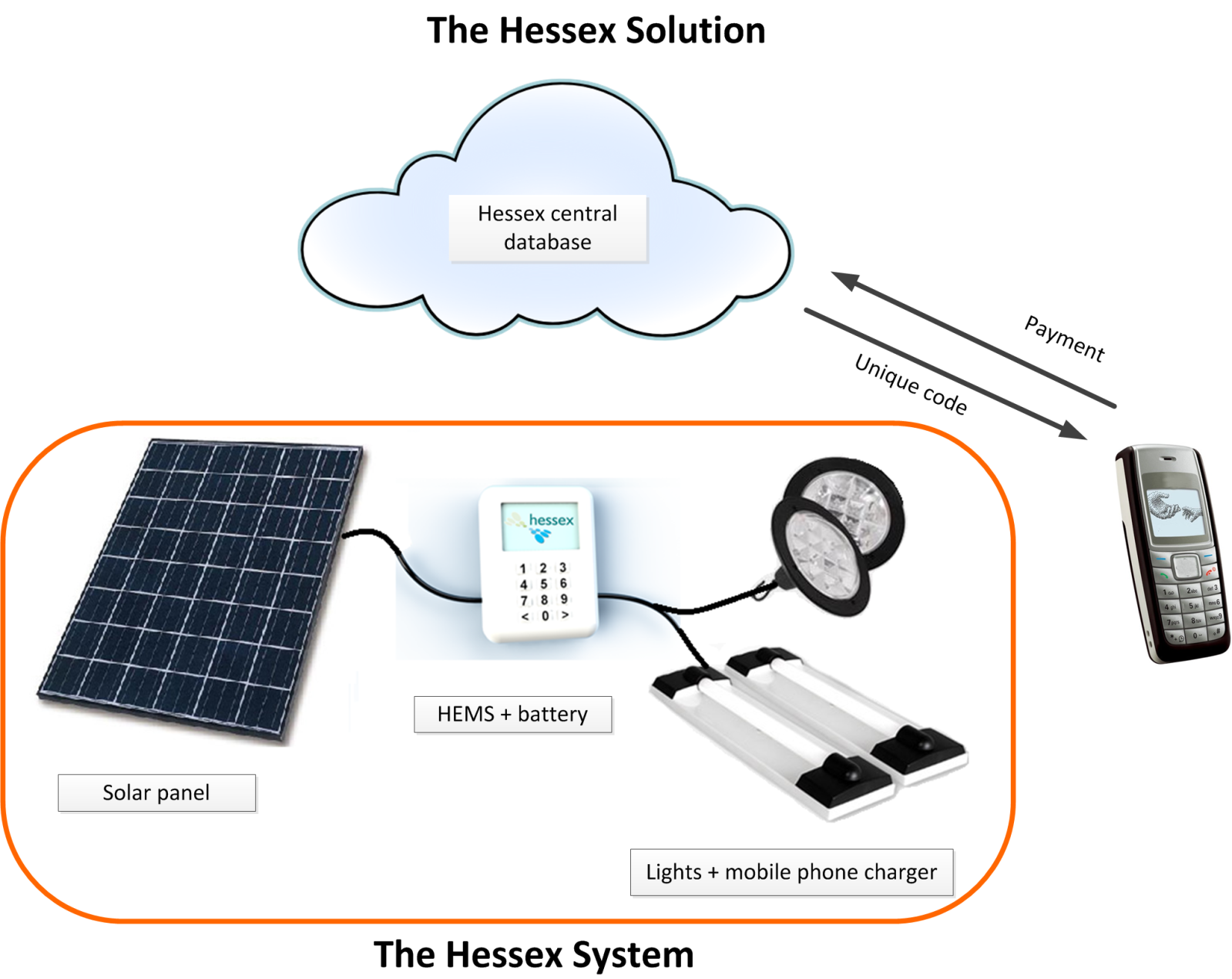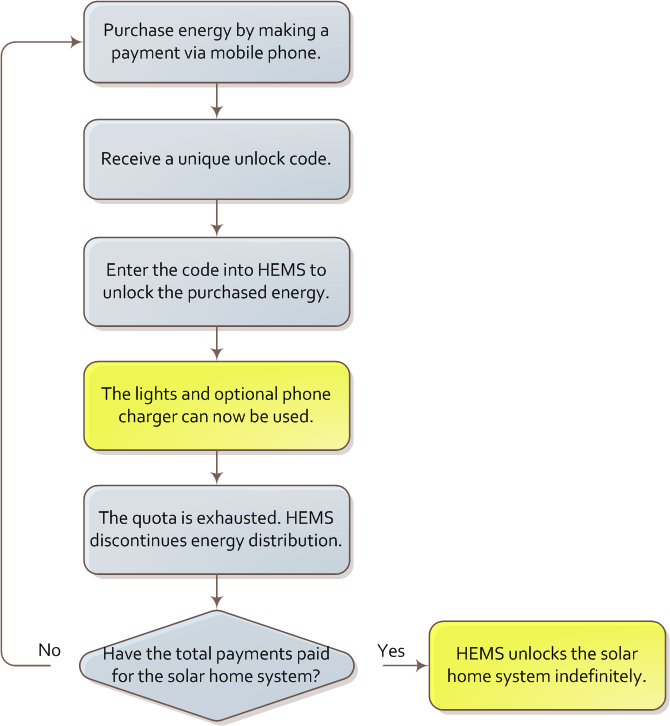Hessex
Overview
Category: Renewable Energies
Event: Global Social Business Competition 2012
Rank: Winner
Team: Boyd Whalan, Daniel Wilson, Edward, Annabelle Kennett, Jack Dostine
Project Status


2.4 billion people have no access to clean energy sources. Bottom of pyramid (BoP) consumers devote many hours to the daily collection of firewood while other sources such as charcoal and kerosene can cost up to $2-$3 a week out of a $7 family income. The indoor pollution created by dirty fuels kill more people every year than malaria. In addition to the health problems caused, these fuels are expensive in terms of monetary value, time and social cost.
A clean energy alternative is available to dirty fuels: A Solar Home System
A typical solar home system comprises a solar panel, battery, one or more energy efficient lights and sometimes mobile phone charging attachments. Their distribution to the poor is impeded by two problems. First, while solar home systems pay for themselves within months through reduced fuel costs, upfront cost and inflexible payment plans provide barriers for poor consumers with inconsistent incomes. Secondly, loan servicing costs prohibit the servicing of remote areas.
Our solution to the problem of dirty fuels is a package made up of:
(a) an off-the-shelf solar home system from an award winning solar manufacturer and
(b) proprietary technology known in the form of a HEMS unity that allows bottom of the pyramid consumers to operate their solar home system by making regular small payments via their mobile phone (see diagram below). The proprietary technology is know as the Hessex Energy Management System (HEMS). The HEMS unit is integrated with the solar home system’s battery to control the distribution of energy to the lights and optional mobile phone charger. The HEMS unit can then ensure that BoP consumers only pay for the solar energy that they use.
Customers purchase a package consisting of a HEMS unit + solar home system for a small upfront payment and then operate the system using the following process:
This process is similar to unlocking airtime on a pre-paid mobile phone, or using a coin operated laundry machine. Users must pay to access the service and only pay for what they use.
Kerosene expenditure can equate to $1500 dollars over the useful life of a home solar product (10 years). By contrast, a family sized solar home system product coupled with the HEMS unit will have a total cost of between $100-200.
A significant proportion of the market can afford small, low quality solar home system. However, the use of the HEMS unit will open up a completely new tier of product to BoP consumers who otherwise could not afford them. These products can light a four bedroom house as well as providing mobile charging facilities and power for a radio. Through our flexible payment system, these products are made affordable for even the most unreliable family incomes.
We will leverage existing, highly reliable Micro Finance Institution (MFI) infrastructure to handle distribution and maintenance. MFIs currently provide loans to over 150 million poor consumers and are growing by 30% per year. Leveraging these existing networks has enormous potential to radically increase the affordability and accessibility of clean energy for poor communities. In addition to providing loans to existing borrowers, microfinance can also play an important role in finding and financing local networks of energy entrepreneurs, individuals who can act on behalf of an MFI in their own communities. These networks will accelerate the distribution of the package into areas microfinance networks may not directly reach. Despite enormous potential, to date, MFIs have struggled to implement energy loan programs in a scalable manner due to high costs of loan servicing, a lack of access to a reliable product supply chain and limited financial support. We address this with our central Hessex database. This database stores information on each of our customers’ payments and account balances, and integrates with the MFI’s existing IT infrastructure. This database will automatically manage all repayments. Additionally, it will integrate with existing MFI IT infrastructure to handle administration, eliminating any burden on the MFIs. In particular, the automatic nature of the loan servicing eliminates the need for loan-servicing by loan officers. This allows MFIs to extend their operations into more sparsely populated areas allowing benefits to flow to the poorest, most remote BoP consumers.
Market Size
The majority of the 2.4 billion people in the world who lack sufficient access to energy are in Africa and Asia. These households and businesses spend up to 30% of their income on unclean fuels such as kerosene, charcoal, and firewood. $38 billion is spent annually on kerosene alone. These fuels are polluting, unsafe, often expensive and difficult to access reliably. Additionally, these households already have one or more mobile phones capable of making payments by sms.
Social impact could be measured in several ways.
Consumer surveys will determine the following:
1. Average hours of solar light accessed per night
2. The number of hours saved from collecting firewood (especially for children and women)
3. Money saved from buying expensive charcoal or kerosene for lighting
4. Average hours per night children are able to study under high quality solar light.
Local government sources could also provide information about any decreases in health problems resulting from decreased indoor pollution.
Usage data which is collected by our databases will determine the kilowatt hours of harmful fossil fuels which have been reduced through the use of solar power.
Efficient distribution
Hessex’s business model is based on:
(i) low cost product sourcing derived from bulk purchases,
(ii) attaching our HEMS
(iii) identifying reliable suppliers who provide cheap distribution right to the MFIs door, and
(iv) providing MFIs with a commission based on a percentage of each SMS payment.
By providing systems to the MFI at a low percentage of the total price, we are able to reduce their risk and increase their ability to distribute at a large scale. SMS repayments provide the remainder of the balance, and the commission system incentivises the MFI to distribute systems and maintain a high quality portfolio of reliable customers.
With this model, IE provides suppliers with access to customers, and provides MFIs with access to a profitable, low service cost loan product that meets the needs of clients with low irregular incomes. The model is made financially attractive to MFI partners and entrepreneurs through the provision of high quality products at a low cost and low risk to the MFI, and the ability to expand their markets to reach more remote, poorer customers.
SMS Enabled pay-as-you-go system
We sell the products to MFIs for 15% of the price and they sell it on for the same amount of the price which recoups the MFIs initial outlay and reduces their risk. The product operates under our unique pay-as-you-go technology which allows customers to pre-pay power via mobile wallets.
The MFI sells the product to the consumer at-cost: 15% of the full product price. The consumer then buys a pre-paid energy code via SMS which is linked to their mobile wallet. Consumers can key the code into HEMS which unlocks the corresponding amount of kWhs whilst the payment is recorded in our IT platform and contributes to payoff the overall system. Once full payment is made the system unlocks indefinitely. We can price our systems so that they provide a cheaper alternative to kerosene in the long run.
In addition to partnering with MFIs, Hessex will build an IT platform that seamlessly integrates into their own management information systems so that they know detailed information about payments collected, payments outstanding and other information key to their business.
A replicable and scalable business model
Hessex’s business model is applicable to many products that are currently out of the reach of consumers at the bottom-of-the-pyramid. Through a focus on technology-enabled distribution using MFIs as infrastructure platforms, IE is scalable in terms of both market size and product offering.
The Hessex Energy Management System is flexible to the needs of the bottom of the pyramid consumer earning an unreliable income of $1-$6 a day, with fluctuating financial capabilities. It also reduces the need for microfinance institutions (MFIs) to send loan officers to collect repayments, thus reducing overheads. This reduction in costs allows the MFI to increase its customer base and service more rural, sparsely populated areas where residents are in the most need for clean energy.
Hessex will partner with manufacturers and distributors of clean energy products for high volume procurement and delivery. This approach ensures that the highest quality products reach the most remote consumers at affordable prices.
By 2013 Hessex will partner with 6 MFIs in Ghana with access a borrower base of 60,000, with 96-97% repayment rates. Together, these MFIs operate in communities that allow for access to a market of 1.5 million potential customers of solar energy products.
Hessex addresses the problem of distribution by utilising the existing networks of MFIs and reducing the contact time required for repayment collection, a fundamental driver for the rural energy poor. The difference with our approach is that we want to build a product that is specifically tailored for MFIs. This allows us to avoid traditional retailers and plug into MFI infrastructure quickly
Eight19 has implemented payments which unlock devices for a period of time, rather than basing payment on actual usage. This is a less flexible approach as it does not allow for the irregularity and unreliability of the income which bottom of the pyramid consumers earn.
Hessex is partnering with the supplier of the highest quality, most affordable solar products available for the poor. Each system is small and modular which avoids installation overheads and increases mobility and ease of use.
Once sufficient energy purchases have been made, the Hessex system is unlocked indefinitely. Unlike with Mobisol, users are never locked into a micro-grid.
Hessex will be working in synergy with manafacturers and distributors of renewable energy products. Our main sources of competition come from alternative methods of energy delivery, and from other companies targeting renewable energy devices to the rural poor.
At the current point in time, solar is the only affordable and reliable technology which can provide electricity to the rural poor. This is due to issues of affordability and transport.
There are however other companies attempting to address energy poverty. There are two main competitors in this field.
1. Eight19 has recently started a trial of pay as you go solar in Kenya.
2. Mobisol has a mobile activated system for villages, targeted at larger solar units.
Strengths
- Huge market with no clear industry leader
- Access to a huge network of reliable clients through MFIs
- Access to the highest quality solar energy products available to the poor
Weaknesses
- High working capital requirement before business is cash flow positive
- Business model is based in third world countries with more volatile political environments
Opportunities
- Expand throughout Africa and into Asia
- Apply our technology to other products such as solar powered water filters and pumps
Threats
- New technologies which make our system redundant
- Government investment in reliable power grids for remote areas





